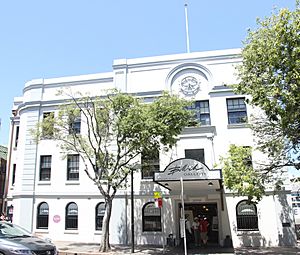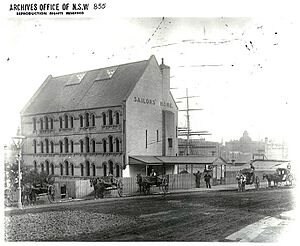Sydney Sailors' Home facts for kids
Quick facts for kids Sydney Sailors' Home |
|
|---|---|

Sydney Sailors' Home, pictured in 2019
|
|
| Location | 106-108 George Street, The Rocks, City of Sydney, New South Wales, Australia |
| Built | 1864–1926 |
| Architect |
|
| Architectural style(s) |
|
| Owner | Property NSW |
| Official name: Sailor's Home (former); Sailors' Home; Marionette Theatre; The Rocks Heritage and Information Centre | |
| Type | State heritage (built) |
| Designated | 10 May 2002 |
| Reference no. | 1576 |
| Type | Barracks & housing |
| Category | Defence |
| Lua error in Module:Location_map at line 420: attempt to index field 'wikibase' (a nil value). | |
The Sydney Sailors' Home is a special building in The Rocks, a historic area in Sydney, Australia. It used to be a place where sailors could stay, a theatre, and a visitor's centre. Today, it is an art gallery and a restaurant.
The building was designed and built in two main parts. The first part was finished in 1864 by architects Weaver & Kemp. Later, in 1926, Spain & Cosh added more to the building. This historic site is also known as the former Marionette Theatre and The Rocks Heritage and Information Centre. It is owned by Property NSW, which is part of the Government of New South Wales. The Sydney Sailors' Home was added to the New South Wales State Heritage Register on 10 May 2002, meaning it is protected for its historical importance.
Contents
A Home for Sailors: Its Early Days
In 1860, the government decided to give land near Circular Quay to a group called the Committee of the Sydney Sailors' Home. This group wanted to help sailors by giving them a safe and affordable place to stay when they were in port.
The land where the Home was built used to be sandstone cliffs and a sandy beach. Before the Home, the Water Police used part of the site from 1846 to 1853. They even used a small cottage nearby, called Cadman's Cottage, as a court and jail. The location was perfect for the Home because it was close to the busy port and a church for sailors.
Sailors' homes were very important in big port cities like Sydney in the 1800s. They offered clean, comfortable, and cheap rooms for sailors from all over the world. These homes helped improve the lives of sailors.
Architects Weaver and Kemp designed the first part of the Home. Their design was similar to a large maritime building in London. The northern part of the building was finished in 1864. It had four floors. The basement, made of sandstone, held the kitchen and dining areas. The upper floors were made of brick with nice sandstone details around the windows.
Growing Bigger: New Additions
Many years later, in 1916, a special gift of money allowed the Home to add a new section called the Carss Wing. Then, in 1925, the Sydney City Council approved plans for a much bigger addition. This new part, designed by Spain & Cosh, was completed in 1926. It was shaped like an 'L' and connected to the older 1864 building. This new section faced George Street and had a different architectural style.
The history of the Sailors' Home is closely connected to the nearby Cadmans Cottage. The first manager of the Home lived in Cadman's Cottage from 1865 until 1926. After that, the new part of the Home provided a home for the manager. Cadman's Cottage was then used for extra sailor accommodation until the late 1950s.
Changing Uses Over Time
In 1970, the Sydney Cove Redevelopment Authority took over the site. Around this time, sailors started earning more money and expected better places to stay. Because of this, fewer sailors used the Home, and it became less popular.
From 1980 to 1981, plans were made to turn the building into a home for the Marionette Theatre of Australia. This involved big changes to the building's inside. The theatre opened in 1983, but it closed down in the late 1980s.
Later, from 1991 to 1993, the building was changed again to become The Rocks Heritage and Information Centre. This work helped bring back some of the building's original features. In 1994, the Heritage and Information Centre opened. It later became the Sydney Visitor Centre. In 1995, parts of the building were turned into a restaurant. The Sydney Visitor Centre moved out in 2005.
Today, the building is home to a commercial art gallery featuring the works of Charles Billich. He is a famous artist known for his sports-themed art and his work for the Olympic Games. His art has even been featured on postage stamps in China!
What the Building Looks Like
The Sydney Sailors' Home is actually two buildings joined together on George Street. The front part, which faces George Street, is an L-shaped building with four floors. It connects to another rectangular building of similar height behind it. The L-shaped part has a Classical Revival style, while the rectangular part has Romanesque style windows. A continuous wall at the top, called a parapet, connects both parts.
- Style:
- 1864: Victorian Italianate (a style popular in the Victorian era, inspired by Italian architecture)
- 1926: Inter-War Free Classical (a style from between the World Wars, inspired by classical Greek and Roman buildings)
- Height: Four storeys (floors)
- Roof:
- 1863: Slate (a type of stone tile)
- 1926: Membrane (a waterproof layer)
- Floors: Made of timber (wood)
Building Condition and Changes
As of 1999, the building was in good physical condition. The land underneath has been changed a lot over time, but there's still sandstone bedrock visible near Cadman's Cottage.
Many changes have happened to the building over the years:
- In 1926, the L-shaped addition almost doubled the building's size. The old sloped roof was removed and replaced with a flat roof.
- In 1983, the building was changed to create the 200-seat Marionette Theatre. This involved big structural changes. A middle floor (mezzanine gallery) was removed at this time.
- From 1991 to 1993, when it became The Rocks Heritage and Information Centre, some of the features removed for the theatre, like the mezzanine gallery, were put back. New stairs were added to connect different levels, and kitchens were put in for the restaurant.
- The changes made for the Heritage Centre were designed so they could be easily undone if needed.
- In 2006, the building was updated again to become an art gallery.
Why the Sydney Sailors' Home is Important
The Sydney Sailors' Home and its land are very important to the history and culture of New South Wales. It's also a key part of The Rocks area, which is important on its own.
The Home is significant because it shows how ideas about helping people changed in the 1800s and 1900s. The building itself tells a story about how sailors were housed and cared for. It shows what working-class people, especially sailors, expected in the 1800s. Even as the building grew, it kept these standards well into the 1900s. You can still see details inside and outside that show how the building was first used.
The building's history also shows how social values changed. For example, it once had separate areas for different groups of sailors, which were later removed. The Home became less popular in the 1970s when sailors' wages increased, and they could afford better accommodation.
The original part of the Home, built in the 1860s, was part of a grand plan. This shows that Sydney was becoming an important city in the mid-1800s. People in the colony wanted to create buildings that matched those in Britain. This means the Sailors' Home is a good example of how Australia looked to British architectural styles at that time.
The Home's history is also strongly linked to its location. Its connection to Cadman's Cottage, The Mariners' Church, Circular Quay, and the other historic buildings in The Rocks makes it very important.
The original Sydney Sailors' Home, designed by Weaver & Kemp, is one of the earliest examples of the Romanesque Revival Style in Sydney. The additions made in the 1920s by Spain & Cosh are also a great example of how new parts of a building can fit well with the older parts.
The Sydney Sailor's Home was officially listed on the New South Wales State Heritage Register on 10 May 2002 because it met several important criteria:
- It shows the history of New South Wales.
The Sailors' Home and its site are important because they show how social welfare changed over time. The building itself shows how sailors were housed and what was expected for working-class people in the 1800s and 1900s. It also shows how social values changed, like the removal of separate facilities for different groups of sailors. The building's design also shows how Sydney wanted to be like major British cities in the 1800s. Its strong connection to other historic places in The Rocks, like Cadman's Cottage, also makes it historically important.
- It shows great design and creative achievement in New South Wales.
The original Sailors' Home is one of the first buildings in Sydney to use the Romanesque Revival Style. The additions from the 1920s are also a good example of how new building parts can be designed to fit well with existing structures.


